Canadian federalism involves the current nature and historical development of the federal system in Canada.

The Constitution Act, 1867 is a major part of the Constitution of Canada. The Act created a federal dominion and defines much of the operation of the Government of Canada, including its federal structure, the House of Commons, the Senate, the justice system, and the taxation system. The British North America Acts, including this Act, were renamed in 1982 with the patriation of the Constitution ; however, it is still known by its original name in United Kingdom records. Amendments were also made at this time: section 92A was added, giving provinces greater control over non-renewable natural resources.
Pith and substance is a legal doctrine in Canadian constitutional interpretation used to determine under which head of power a given piece of legislation falls. The doctrine is primarily used when a law is challenged on the basis that one level of government has encroached upon the exclusive jurisdiction of another level of government.
In many Commonwealth jurisdictions, the phrase "peace, order, and good government" (POGG) is an expression used in law to express the legitimate objects of legislative powers conferred by statute. The phrase appears in many Imperial Acts of Parliament and Letters Patent, most notably the constitutions of Barbados, Canada, Australia and formerly New Zealand and South Africa.
Canadian constitutional law is the area of Canadian law relating to the interpretation and application of the Constitution of Canada by the courts. All laws of Canada, both provincial and federal, must conform to the Constitution and any laws inconsistent with the Constitution have no force or effect.

Reference Re Validity of Section 5(a) of the Dairy Industry Act (1949), also known as the Margarine Reference or as Canadian Federation of Agriculture v Quebec (AG), is a leading ruling of the Supreme Court of Canada, upheld on appeal to the Judicial Committee of the Privy Council, on determining if a law is within the authority of the Parliament of Canada's powers relating to criminal law. In this particular case, the Court found that a regulation made by Parliament was ultra vires. Though the regulation contained sufficient punitive sanctions, the subject matter contained within it was not the kind that served a public purpose.

Citizens Insurance Co of Canada v Parsons is a major Canadian constitutional case decided by the Judicial Committee of the Privy Council. It interpreted the property and civil rights clause of section 92(13) in the Constitution Act, 1867 to be read expansively, to include contracts related to insurance to be within the power of the provincial governments, but the countervailing Trade and Commerce clause of section 91(2) was to be read narrowly.

Ontario (AG) v Canada (AG), also known as the Local Prohibition Case, was a famous Canadian constitutional decision by the Judicial Committee of the Privy Council. It was one of the first cases to enunciate core principles of the federal peace, order and good government power.

Re Board of Commerce Act 1919 and the Combines and Fair Prices Act 1919, commonly known as the Board of Commerce case, is a Canadian constitutional decision of the Judicial Committee of the Privy Council in which the "emergency doctrine" under the federal power of peace, order and good government was first created.

Ontario (AG) v Canada Temperance Federation was a famous Canadian constitutional decision of the Judicial Committee of the Privy Council and was among the first cases to examine the peace, order, and good government power of the Constitution Act, 1867. It was the first decision to bring back the "national concerns" branch of peace, order and good government since it was first suggested in the Local Prohibitions case.

Toronto Electric Commissioners v Snider is a famous Canadian constitutional decision of the Judicial Committee of the Privy Council where the Council struck down the federal Industrial Disputes Investigation Act, precursor to the Canada Labour Code. The Court identified matters in relation to labour to be within the exclusive competence of the province in the property and civil rights power under section 92(13) of the Constitution Act, 1867. This decision is considered one of the high-water marks of the Council's interpretation of the Constitution in favour of the provinces.
Section 91(27) of the Constitution Act, 1867, also known as the criminal law power, grants the Parliament of Canada the authority to legislate on:
27. The Criminal Law, except the Constitution of Courts of Criminal Jurisdiction, but including the Procedure in Criminal Matters.
Section 91(2) of the Constitution Act, 1867, also known as the trade and commerce power, grants the Parliament of Canada the authority to legislate on:
2. The Regulation of Trade and Commerce.

British Coal Corp v R is a decision of the Judicial Committee of the Privy Council in which the authority of the Canadian Parliament to prohibit appeals to the JCPC in criminal cases was upheld.

Reference Re Securities Act is a landmark opinion of the Supreme Court of Canada to a reference question posed on the extent of the ability of the Parliament of Canada to use its trade and commerce power.

Quebec (AG) v Canada (AG), also known as the Radio Reference, is a decision of the Judicial Committee of the Privy Council that determined that broadcasting fell within the jurisdiction of the Parliament of Canada under the British North America Act, 1867.

Canada (AG) v British Columbia (AG), also known as the Reference as to constitutional validity of certain sections of The Fisheries Act, 1914 and the Fish Canneries Reference, is a significant decision of the Judicial Committee of the Privy Council in determining the boundaries of federal and provincial jurisdiction in Canada. It is also significant, in that it represented a major victory in the fight against discrimination aimed at Japanese Canadians, which was especially prevalent in British Columbia in the early part of the 20th century.

Canada (AG) v Ontario (AG)[1937] UKPC 6, [1937] A.C. 326, also known as the Labour Conventions Reference, is a landmark decision of the Judicial Committee of the Privy Council concerning the distinct nature of federal and provincial jurisdiction in Canadian federalism.
Section 92(14) of the Constitution Act, 1867, also known as the administration of justice power, grants the provincial legislatures of Canada the authority to legislate on:
14. The Administration of Justice in the Province, including the Constitution, Maintenance, and Organization of Provincial Courts, both of Civil and of Criminal Jurisdiction, and including Procedure in Civil Matters in those Courts.

Reference re Pan‑Canadian Securities Regulation, 2018 SCC 48 is a landmark decision of the Supreme Court of Canada, dealing with the Canadian doctrine of cooperative federalism and how it intersects with the power of the Parliament of Canada over trade and commerce, as well as discussing the nature of parliamentary sovereignty in Canada.






